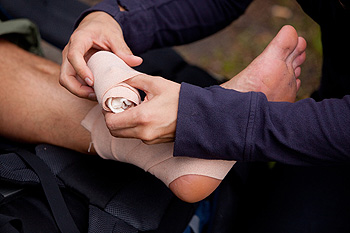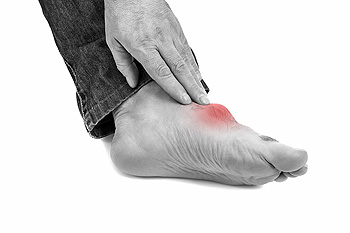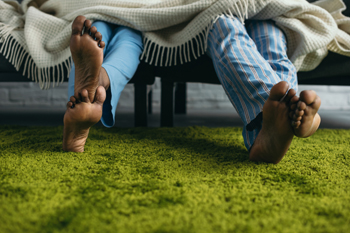Items filtered by date: August 2020
Who Needs an Ankle Brachial Index Test?
 Peripheral artery disease, also known as PAD, is a condition that results in poor circulation to the lower limbs. Typical symptoms of PAD include leg pain or muscle cramps when walking, numbness, weakness, or coldness in your legs. An ankle brachial index is a quick, noninvasive, and painless test used to screen for PAD. The measurements can highlight any potential problems, like blockages or partial blockages in blood flow to your extremities.To do this test, a doctor simply takes your blood pressure at your arms and at your ankles and compares the numbers to come up with a numerical ratio that represents your risk of having or developing PAD. While anyone can get the ankle brachial index test, people who have pre-existing risk factors for developing PAD are especially encouraged to undergo this screening. Risk factors include a history of smoking, high blood pressure, high cholesterol, diabetes, and atherosclerosis. For more information about the ankle brachial index and other tests for PAD, speak with a podiatrist today.
Peripheral artery disease, also known as PAD, is a condition that results in poor circulation to the lower limbs. Typical symptoms of PAD include leg pain or muscle cramps when walking, numbness, weakness, or coldness in your legs. An ankle brachial index is a quick, noninvasive, and painless test used to screen for PAD. The measurements can highlight any potential problems, like blockages or partial blockages in blood flow to your extremities.To do this test, a doctor simply takes your blood pressure at your arms and at your ankles and compares the numbers to come up with a numerical ratio that represents your risk of having or developing PAD. While anyone can get the ankle brachial index test, people who have pre-existing risk factors for developing PAD are especially encouraged to undergo this screening. Risk factors include a history of smoking, high blood pressure, high cholesterol, diabetes, and atherosclerosis. For more information about the ankle brachial index and other tests for PAD, speak with a podiatrist today.
Vascular testing plays an important part in diagnosing disease like peripheral artery disease. If you have symptoms of peripheral artery disease, or diabetes, consult with Dr. Joshua David Scoll from Pennsylvania. Our doctor will assess your condition and provide you with quality foot and ankle treatment.
What Is Vascular Testing?
Vascular testing checks for how well blood circulation is in the veins and arteries. This is most often done to determine and treat a patient for peripheral artery disease (PAD), stroke, and aneurysms. Podiatrists utilize vascular testing when a patient has symptoms of PAD or if they believe they might. If a patient has diabetes, a podiatrist may determine a vascular test to be prudent to check for poor blood circulation.
How Is it Conducted?
Most forms of vascular testing are non-invasive. Podiatrists will first conduct a visual inspection for any wounds, discoloration, and any abnormal signs prior to a vascular test.
The most common tests include:
- Ankle-Brachial Index (ABI) examination
- Doppler examination
- Pedal pulses
These tests are safe, painless, and easy to do. Once finished, the podiatrist can then provide a diagnosis and the best course for treatment.
If you have any questions, please feel free to contact one of our offices located in Philadelphia, Bensalem, and Fairless Hills, PA . We offer the newest diagnostic and treatment technologies for all your foot care needs.
Do Your Child's Feet Hurt?
Ankle Sprains Among Athletes
 Ankle sprains are a common injury faced by athletes. The usual symptoms of an ankle sprain include pain, tenderness, swelling, bruising, and a restricted range of motion in the affected ankle. Ankle sprains are classified into three different categories by their level of severity. A Grade 1 sprain is considered mild and is characterized by ligaments stretched, but there is no tear. A Grade 2 sprain is characterized by a partial tear in the ligament and is known as the most common degree of an ankle sprain. A Grade 3 sprain is the most severe type, and is characterized by a complete tear in the ligament. If you suspect you have sprained your ankle, it is strongly recommended that you visit a podiatrist as soon as possible to begin treatment.
Ankle sprains are a common injury faced by athletes. The usual symptoms of an ankle sprain include pain, tenderness, swelling, bruising, and a restricted range of motion in the affected ankle. Ankle sprains are classified into three different categories by their level of severity. A Grade 1 sprain is considered mild and is characterized by ligaments stretched, but there is no tear. A Grade 2 sprain is characterized by a partial tear in the ligament and is known as the most common degree of an ankle sprain. A Grade 3 sprain is the most severe type, and is characterized by a complete tear in the ligament. If you suspect you have sprained your ankle, it is strongly recommended that you visit a podiatrist as soon as possible to begin treatment.
Sports related foot and ankle injuries require proper treatment before players can go back to their regular routines. For more information, contact Dr. Joshua David Scoll of Pennsylvania. Our doctor can provide the care you need to keep you pain-free and on your feet.
Sports Related Foot and Ankle Injuries
Foot and ankle injuries are a common occurrence when it comes to athletes of any sport. While many athletes dismiss the initial aches and pains, the truth is that ignoring potential foot and ankle injuries can lead to serious problems. As athletes continue to place pressure and strain the area further, a mild injury can turn into something as serious as a rupture and may lead to a permanent disability. There are many factors that contribute to sports related foot and ankle injuries, which include failure to warm up properly, not providing support or wearing bad footwear. Common injuries and conditions athletes face, including:
- Plantar Fasciitis
- Plantar Fasciosis
- Achilles Tendinitis
- Achilles Tendon Rupture
- Ankle Sprains
Sports related injuries are commonly treated using the RICE method. This includes rest, applying ice to the injured area, compression and elevating the ankle. More serious sprains and injuries may require surgery, which could include arthroscopic and reconstructive surgery. Rehabilitation and therapy may also be required in order to get any recovering athlete to become fully functional again. Any unusual aches and pains an athlete sustains must be evaluated by a licensed, reputable medical professional.
If you have any questions please feel free to contact one of our offices located in Philadelphia, Bensalem, and Fairless Hills, PA . We offer the newest diagnostic and treatment technologies for all your foot and ankle needs.
What to Eat to Help Manage Gout
 Gout is a type of arthritis that causes sudden pain, swelling and inflammation of the joints, typically in the big toes. Gout attacks are caused by a buildup of uric acid in the bloodstream. Fortunately, you may be able to minimize the occurrence of gout attacks by altering your diet. To lower the levels of uric acid in your blood, it is recommended that you avoid consuming organ meats, game meats, fish and other seafoods, foods that contain added sugars or yeasts, and sweet beverages such as fruit juices and soda. Foods that are safer for people who suffer from gout include fruits, vegetables, legumes, nuts and seeds, whole grains, low-fat dairy, eggs, coffee, tea, herbs, spices, and plant-based oils. For more information about gout, and for treatment and prevention options, consult with a podiatrist today.
Gout is a type of arthritis that causes sudden pain, swelling and inflammation of the joints, typically in the big toes. Gout attacks are caused by a buildup of uric acid in the bloodstream. Fortunately, you may be able to minimize the occurrence of gout attacks by altering your diet. To lower the levels of uric acid in your blood, it is recommended that you avoid consuming organ meats, game meats, fish and other seafoods, foods that contain added sugars or yeasts, and sweet beverages such as fruit juices and soda. Foods that are safer for people who suffer from gout include fruits, vegetables, legumes, nuts and seeds, whole grains, low-fat dairy, eggs, coffee, tea, herbs, spices, and plant-based oils. For more information about gout, and for treatment and prevention options, consult with a podiatrist today.
Gout is a foot condition that requires certain treatment and care. If you are seeking treatment, contact Dr. Joshua David Scoll from Pennsylvania. Our doctor will treat your foot and ankle needs.
What Is Gout?
Gout is a type of arthritis caused by a buildup of uric acid in the bloodstream. It often develops in the foot, especially the big toe area, although it can manifest in other parts of the body as well. Gout can make walking and standing very painful and is especially common in diabetics and the obese.
People typically get gout because of a poor diet. Genetic predisposition is also a factor. The children of parents who have had gout frequently have a chance of developing it themselves.
Gout can easily be identified by redness and inflammation of the big toe and the surrounding areas of the foot. Other symptoms include extreme fatigue, joint pain, and running high fevers. Sometimes corticosteroid drugs can be prescribed to treat gout, but the best way to combat this disease is to get more exercise and eat a better diet.
If you have any questions please feel free to contact one of our offices located in Philadelphia, Bensalem, and Fairless Hills, PA . We offer the newest diagnostic and treatment technologies for all your foot and ankle needs.
Preventing Falls at Home
 Did you know that 60% of falls happen in the home? Preventing these falls is always important, but should become even more of a priority as we age. The older we get the more dangerous falls become. Potential complications from falls can include sprains, broken bones, and in severe cases even traumatic brain injuries. Fortunately, there are things you can do to decrease your risk of falling. If you live in a home with steps or stairs, make sure that the stairs have tightly fastened handrails that you can grip as you walk up and down. Throughout your home, ensure that carpets and rugs are firmly fixed to the floor. In bathrooms, place non-skid mats on surfaces that may get wet. Make sure that your home is well-lit and that tripping hazards, such as electrical cords and small furniture, are kept away from walking areas. Beyond home safety issues, another common cause of falls is compromised foot health. Pain in the feet and ankles, poor circulation, gait abnormalities, and improper footwear could all increase your risk of falling. For more advice and to help reduce your risk, speak with a podiatrist today.
Did you know that 60% of falls happen in the home? Preventing these falls is always important, but should become even more of a priority as we age. The older we get the more dangerous falls become. Potential complications from falls can include sprains, broken bones, and in severe cases even traumatic brain injuries. Fortunately, there are things you can do to decrease your risk of falling. If you live in a home with steps or stairs, make sure that the stairs have tightly fastened handrails that you can grip as you walk up and down. Throughout your home, ensure that carpets and rugs are firmly fixed to the floor. In bathrooms, place non-skid mats on surfaces that may get wet. Make sure that your home is well-lit and that tripping hazards, such as electrical cords and small furniture, are kept away from walking areas. Beyond home safety issues, another common cause of falls is compromised foot health. Pain in the feet and ankles, poor circulation, gait abnormalities, and improper footwear could all increase your risk of falling. For more advice and to help reduce your risk, speak with a podiatrist today.
Preventing falls among the elderly is very important. If you are older and have fallen or fear that you are prone to falling, consult with Dr. Joshua David Scoll from Pennsylvania. Our doctor will assess your condition and provide you with quality advice and care.
Every 11 seconds, an elderly American is being treated in an emergency room for a fall related injury. Falls are the leading cause of head and hip injuries for those 65 and older. Due to decreases in strength, balance, senses, and lack of awareness, elderly persons are very susceptible to falling. Thankfully, there are a number of things older persons can do to prevent falls.
How to Prevent Falls
Some effective methods that older persons can do to prevent falls include:
- Enrolling in strength and balance exercise program to increase balance and strength
- Periodically having your sight and hearing checked
- Discuss any medications you have with a doctor to see if it increases the risk of falling
- Clearing the house of falling hazards and installing devices like grab bars and railings
- Utilizing a walker or cane
- Wearing shoes that provide good support and cushioning
- Talking to family members about falling and increasing awareness
Falling can be a traumatic and embarrassing experience for elderly persons; this can make them less willing to leave the house, and less willing to talk to someone about their fears of falling. Doing such things, however, will increase the likelihood of tripping or losing one’s balance. Knowing the causes of falling and how to prevent them is the best way to mitigate the risk of serious injury.
If you have any questions, please feel free to contact one of our offices located in Philadelphia, Bensalem, and Fairless Hills, PA . We offer the newest diagnostic and treatment technologies for all your foot care needs.
Blisters on the Feet Can Protect Damaged Skin
 People who often get blisters on the feet are aware of the discomfort they may cause. Blisters are a small area that can resemble a bubble that forms over the damaged skin. This is filled with fluid that protects the raw skin, and will gradually drain when the healing process is completed. There are several reasons why blisters on the feet can develop, including wearing shoes that do not fit properly, excessive sweating that may come from wearing shoes that are made of non-breathable materials, or from not wearing socks. Research has indicated that it may be beneficial to moisturize the feet prior to wearing shoes. This may help prevent existing blisters from becoming worse. If you get frequent blisters on the feet, it is suggested that you consult with a podiatrist who can guide you toward effective prevention and treatment techniques.
People who often get blisters on the feet are aware of the discomfort they may cause. Blisters are a small area that can resemble a bubble that forms over the damaged skin. This is filled with fluid that protects the raw skin, and will gradually drain when the healing process is completed. There are several reasons why blisters on the feet can develop, including wearing shoes that do not fit properly, excessive sweating that may come from wearing shoes that are made of non-breathable materials, or from not wearing socks. Research has indicated that it may be beneficial to moisturize the feet prior to wearing shoes. This may help prevent existing blisters from becoming worse. If you get frequent blisters on the feet, it is suggested that you consult with a podiatrist who can guide you toward effective prevention and treatment techniques.
Blisters may appear as a single bubble or in a cluster. They can cause a lot of pain and may be filled with pus, blood, or watery serum. If your feet are hurting, contact Dr. Joshua David Scoll of Pennsylvania. Our doctor can provide the care you need to keep you pain-free and on your feet.
Foot Blisters
Foot blisters are often the result of friction. This happens due to the constant rubbing from shoes, which can lead to pain.
What Are Foot Blisters?
A foot blister is a small fluid-filled pocket that forms on the upper-most layer of the skin. Blisters are filled with clear fluid and can lead to blood drainage or pus if the area becomes infected.
Symptoms
(Blister symptoms may vary depending on what is causing them)
- Bubble of skin filled with fluid
- Redness
- Moderate to severe pain
- Itching
Prevention & Treatment
In order to prevent blisters, you should be sure to wear comfortable shoes with socks that cushion your feet and absorb sweat. Breaking a blister open may increase your chances of developing an infection. However, if your blister breaks, you should wash the area with soap and water immediately and then apply a bandage to the affected area. If your blisters cause severe pain it is important that you call your podiatrist right away.
If you have any questions, please feel free to contact one of our offices located in Philadelphia, Bensalem, and Fairless Hills, PA . We offer the newest diagnostic and treatment technologies for all your foot care needs.

